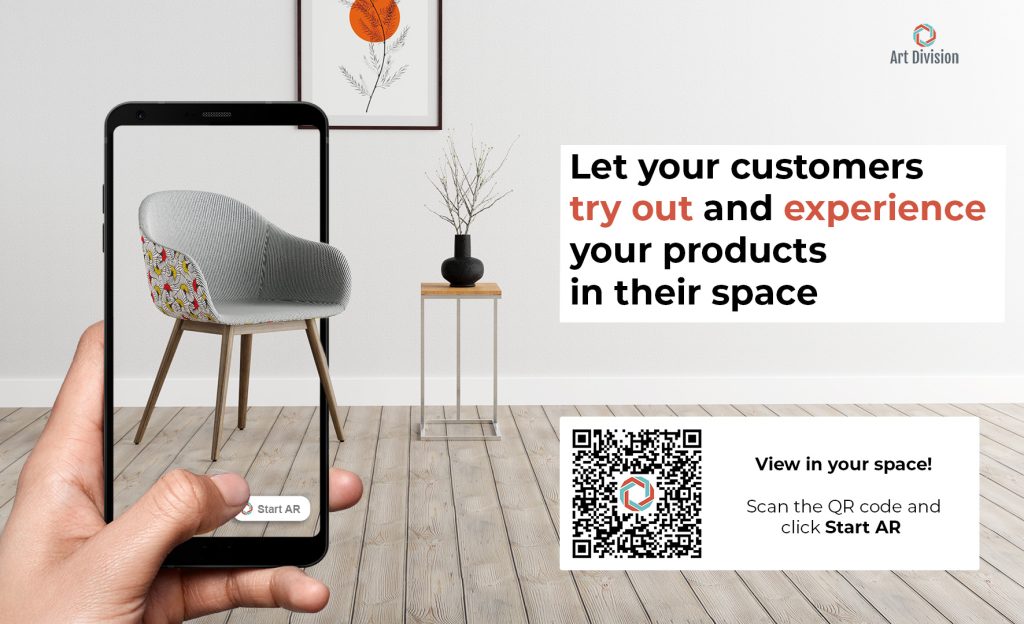Augmented Reality (AR) is no longer just a buzzword—it’s revolutionising the world of e-commerce by enhancing customer experiences and bridging the gap between online and physical shopping. As businesses strive to deliver more interactive and personalised shopping experiences, AR has become an essential tool for brands looking to stand out in a competitive digital marketplace.
In this guide, we’ll dive deep into how augmented reality in e-commerce works, its benefits, and the transformative impact it’s having on online shopping.
How augmented reality works in e-commerce
AR technology enhances the shopping experience by overlaying digital content onto a user’s real-world surroundings. For e-commerce, this means enabling users to interact with virtual products in their physical space. The technology relies on cameras, sensors, and software algorithms to achieve this. Essentially, AR maps a user’s environment in real-time and projects digital elements, like products, onto it.
One of the major advancements in this field is the use of WebAR, which enables users to experience AR directly through a website, eliminating the need for downloading additional apps. WebAR is a game-changer for e-commerce because it makes the entire process more accessible, faster, and seamless for users who want an instant, on-demand experience.
This removes friction from the shopping journey and allows customers to easily engage with AR features at the click of a button.
Benefits of AR for e-commerce businesses
Augmented Reality (AR) offers a range of compelling benefits for e-commerce businesses, transforming the way customers interact with products and make purchasing decisions. Here are some of the key advantages:
1. Enhanced customer engagement:
AR captivates users by providing them with an interactive shopping experience. Whether it’s virtually trying on clothes or viewing how a piece of furniture fits in their home, AR engages customers in ways that traditional e-commerce cannot. This level of interaction leads to longer time spent on the website, which can increase the likelihood of a purchase.
2. Reduced return rates:
One of the biggest challenges in e-commerce is the high rate of product returns, often caused by customers receiving items that don’t meet their expectations. AR helps solve this issue by allowing customers to see and experience the product more accurately before they buy. For example, AR features can show how a pair of sunglasses will look on the customer’s face, helping them make more confident decisions, and ultimately reducing returns.
3. Personalized shopping experiences:
AR can provide highly personalized shopping experiences tailored to the customer’s preferences. For instance, AR tools can recommend complementary products based on what the customer has tried on or viewed. This not only enhances the customer’s experience but also increases average order value by suggesting additional purchases.
4. Increased brand loyalty:
Offering innovative technology like AR can help create a stronger emotional connection with customers. Brands that adopt AR show that they are forward-thinking and focused on improving the customer experience, which can lead to increased customer loyalty. When shoppers have memorable, engaging experiences, they are more likely to return to the brand in the future.
How AR transforms online shopping behavior
The introduction of AR into e-commerce has reshaped how consumers approach online shopping. By offering an immersive, interactive experience, AR bridges the gap between online and in-store shopping, addressing some of the key barriers to online purchases.
1. Visualizing products in real-time
One of the most impactful features of AR is its ability to help customers visualize how specific products will look in their own environment. For example, a customer shopping for a sofa online can use AR to place a true-to-size, 3D model of the sofa in their living room. Not only can they see how the sofa fits in terms of size and dimensions, but they can also experiment with different color options to see how it complements their existing decor. This functionality enables users to compare how the new sofa will match their current furniture, wall colors, and overall interior design. By offering this kind of detailed visualization, AR empowers customers to make more confident and informed decisions.
2. Bringing the in-store experience online—and beyond
While visiting physical stores allows customers to see and touch products, it doesn’t allow them to try the items in their own home or see how they’ll fit in their personal space. This is where AR truly excels. With AR, customers can do something that even in-store shopping cannot offer: they can “bring” the product into their home environment. For instance, instead of just imagining how a sofa might look in a store, AR lets users place it directly in their living room, visualize the colors, and see how it matches with their existing furniture. This enhanced capability makes AR a superior option in many cases compared to physical retail shopping.
Case studies of successful AR implementations
Many brands have recognized the potential of AR in transforming the e-commerce landscape, and several companies have implemented AR solutions with great success. These case studies highlight how businesses across different industries are leveraging AR to enhance the shopping experience and drive customer satisfaction.
1. IKEA Place
IKEA, one of the leading global furniture retailers, introduced its AR app called IKEA Place, which enables customers to visualize furniture in their homes before buying. By simply using a smartphone, users can select furniture from IKEA’s catalog and place it virtually in their rooms to see how it fits in terms of size, color, and style. This AR feature has proven especially valuable in reducing the hesitation around buying large furniture items online and has significantly lowered the number of returns by ensuring customers make more informed decisions.
2. LeFeu Fires’ WebAR configurator
LeFeu Fires, a luxury fireplace brand, provides an innovative WebAR configurator that allows customers to design and visualize custom fireplaces in their homes. By using this tool, customers can explore different styles and configurations and place the product in their real-world environment to see how it will look before making a purchase. This personalized experience has simplified the decision-making process for high-end products and helped increase customer confidence in buying online.
Explore LeFeu Fires’ AR Configurator
These case studies demonstrate how AR can transform not only the customer experience but also the overall success of an e-commerce platform. By offering innovative and interactive shopping tools, brands are able to engage their audience more effectively and create a memorable, user-friendly shopping journey.
The future of augmented reality in e-commerce
The future of augmented reality in e-commerce looks promising as the technology continues to evolve, becoming more accessible and widespread. While AR is currently being used predominantly by high-end and luxury brands, this trend is expected to shift in the coming years. Here’s what the future holds for AR in the online shopping space:
1 Expansion beyond luxury brands
At the moment, AR is often associated with premium brands and expensive products, such as luxury furniture, fashion, and beauty products. However, as the technology becomes more affordable and easier to implement, AR will extend its reach to mid-tier and even budget-friendly brands. As businesses in more affordable segments adopt AR, consumers will come to expect interactive experiences across a broader range of product categories, making AR a standard feature in online shopping.
2. Seamless WebAR integration
WebAR will continue to be a game-changer by offering users immediate access to AR experiences without the need for downloading additional apps. As WebAR technology improves, businesses will be able to offer increasingly sophisticated AR experiences directly from their websites. This instant access will further remove barriers for consumers, making the shopping process even smoother and more enjoyable.
3. Personalized shopping at scale
In the future, AR will not only be used for visualization but also for personalization. As AR becomes more advanced, it will be able to offer hyper-personalized recommendations tailored to individual shoppers. Imagine an AR tool that not only shows how furniture will fit into your room but also suggests complementary decor items based on the color scheme and style of your existing space. This kind of personalized interaction will boost engagement and drive higher sales.
4. Integration with AI and data analytics
The next big leap for AR in e-commerce will involve its integration with artificial intelligence (AI) and data analytics. As businesses collect more data about user behavior and preferences, they will be able to deliver more accurate, context-aware AR experiences. For example, AI could analyze a shopper’s previous purchases and browsing history to recommend products that are most likely to appeal to them, enhancing the overall shopping experience.
5. Cross-platform accessibility
As AR technology becomes more standardized, it will work seamlessly across a wide range of devices, from smartphones and tablets to smart glasses and other wearable technology. This cross-platform accessibility will make AR more versatile and appealing to consumers, providing consistent experiences regardless of the device they’re using.
In summary, AR is set to revolutionise e-commerce further by becoming more widely accessible to businesses and consumers alike. As it becomes more mainstream, AR will likely become a standard feature in online shopping experiences, offering everything from instant product visualisation to personalised recommendations.
Challenges of implementing AR in e-commerce
While AR offers numerous benefits to e-commerce businesses, implementing it successfully is not without its challenges. Many companies face hurdles when integrating this advanced technology into their existing platforms. Below are some of the key challenges businesses may encounter:
1. High development costs
Developing high-quality AR experiences can be expensive. From creating 3D models to ensuring the technology works smoothly across devices, the investment required for building a robust AR feature is substantial. Small- and medium-sized businesses may find it difficult to allocate enough resources to AR projects, especially when they also need to maintain other aspects of their e-commerce operations.
2. technical barriers
AR technology is complex and requires significant technical expertise to implement correctly. Ensuring that AR functions seamlessly across a variety of devices—such as smartphones, tablets, and computers—can be a challenge. Additionally, AR must integrate smoothly with the company’s website or app without causing slow load times or compatibility issues.
3. User adoption and education
Although AR is becoming more widespread, some users may still be unfamiliar with the technology or hesitant to use it. Educating customers about how to use AR features and ensuring the process is intuitive and user-friendly is crucial. If customers find the AR interface difficult to use or unnecessary, they may abandon the feature altogether.
4. Maintaining accuracy
Ensuring that AR models are accurate representations of the real products can be a challenge. Inaccurate scaling, poor textures, or unrealistic lighting effects can diminish the overall experience and lead to customer dissatisfaction. Businesses must pay careful attention to the quality of their AR models to ensure they provide an authentic and reliable shopping experience.
Despite these challenges, the rewards of implementing AR successfully can far outweigh the hurdles. As technology advances and becomes more affordable, overcoming these challenges will be easier for businesses of all sizes.
Conclusion: why AR is the future of e-commerce
As consumer expectations evolve, e-commerce businesses must continually find new ways to engage their audiences and enhance the shopping experience. Augmented Reality (AR) has emerged as a powerful tool that goes beyond traditional shopping methods by offering interactive, personalized, and immersive experiences. AR enables customers to visualize products in their own space, try them on virtually, and make more informed purchase decisions—all without stepping foot into a store.
Currently, AR is gaining traction with luxury and high-end brands, but as the technology becomes more affordable and accessible, it will expand to businesses of all sizes. The growing popularity of WebAR will make AR experiences instantly available to consumers without the need for additional apps, creating a smoother, more convenient shopping journey.
In the near future, AR will become a standard feature in e-commerce, offering brands the ability to deliver personalized experiences, increase customer confidence, and drive sales. Companies that adopt AR now will not only stay ahead of the curve but also build stronger relationships with their customers through enhanced engagement and loyalty.
As AR continues to develop and integrate with artificial intelligence and data analytics, the possibilities for creating even more sophisticated, tailored shopping experiences are endless. For e-commerce businesses, adopting AR isn’t just an option—it’s a necessity for staying competitive in the digital age.






